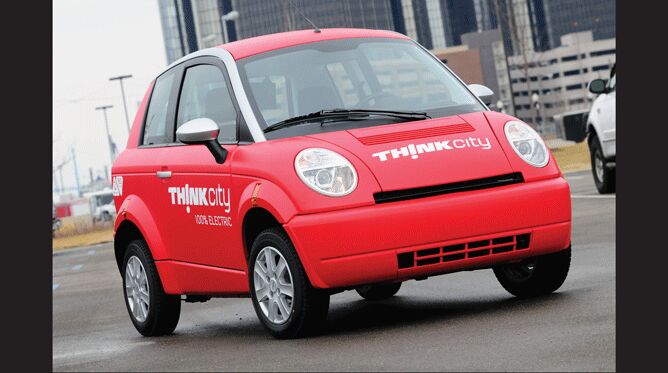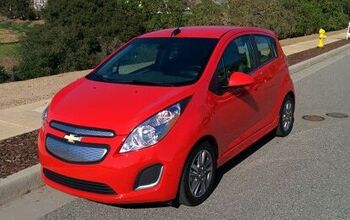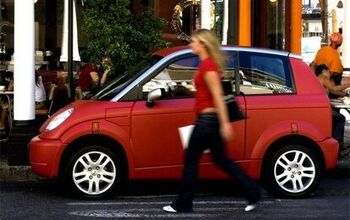Capsule Review: Th!nk EV

What’s the deal with these small cars and their self-righteous names? I’m talking about the Smart, the iQ, and the Think. Does anybody really believe that making a car diminutive turns it into some kind of Einstein? If anything, I’d be happy if car makers showed they understand they have some really stupid machines out there. The Fiat Cretino, the Ford Fiasco, the Opel Idiot, the Mercury Moron: now that’d be Truth in Naming.
When a review starts on a sour note, you know the reviewer did not like the car. True: I did not like the Think. To explain why, I’ll have to digress. At a recent electromobility conference in Zurich, Frank Rinderknecht of Rinspeed (a company that used to be in the business of upping cars till they had about 600 horsepower), explained a successful electric car needed (but seldom had) three things: power, range, and emotional appeal. The made-in-Norway Think has OK power and good range but zero emotional appeal.
Not that it looks bad. The Think manages to be inoffensively non-insectoid, yet, with its large friendly eyes, is recognizable and distinct. I like that it has thermoplastic, through-colored body panels, even though panel gaps are largish. And the interior is OK too: not exactly stylish but modern enough, in a somewhat garage-built way. (Some switches and materials appear to be jarringly cheap, though). For a car similar in size to the Smart, it’s an acceptable package, and offers comfortable, though certainly not luxurious, seating and space for two with four large suitcases. If you can live with Ikea furniture, you could probably live with this.
The electric part is not bad, either. The car I drove on urban roads utilized a Swiss-made Zebra battery set-up. Zebra means cheapish, quite high capacity, easily-recyclable Sodium batteries that have only one major disadvantage: they have to be kept hot. In other words, you have to connect to the grid at least every few days or your batteries conk out. From what I have h
eard, users report few problems after thousands of loading cycles. It sounds OK to me: if I had an EV I’d plug it in every night anyway. And performance is fine too: range is over 100 miles, top speed 62 mph. Satisfyingly, it feels muscular from the start, just as EVs tend to do.
But the start is where the problems begin. The Think doesn’t ride well, which is no wonder since it has a really short wheelbase. It crashes and wobbles over bumps; and the suspension feels underdeveloped, as if it can’t handle the car’s torque. Step on the gas upon topping a traffic-calming ridge and the tires chirp and the whole car shudders. The steering feels lifeless and mushy. And my tester had a noisy vacuum pump. I’m on the record for liking small cars and for liking EVs. But this one feels too cheap.
Dan Neil, I am sorry to say I don’t agree with you. Ford was right to quit this project, and you are wrong. The Think is not a desirable car. It’s laudable that the Think is the second (after the Tesla) crashtest-approved EV on the market. For urban (European) niches, it may be acceptable as a zero-emission vehicle. But to make economic sense, I’d think an EV has to be a good commuter car, which this is not.

More by Martin Schwoerer
Latest Car Reviews
Read moreLatest Product Reviews
Read moreRecent Comments
- ToolGuy There was a time when in a place called America there were roads, and they were paved, and they were paved smoothly enough for a vehicle like this. Perhaps our next President will bring back that concept.
- ToolGuy I suppose I will listen before commenting. (TG, what a fair-minded dude!)
- ToolGuy "The technology is much more advanced to be better than a role model driver,”• Do any of you know what a "role model driver" is? No, I guess you wouldn't. 😉
- ToolGuy I might be Batman.
- Lou_BC Well, I'd be impressed if this was in a ZR2. LOL




































Comments
Join the conversation
According to the Th!nk website, the car is/was available with another battery system that does not have the aforementioned disadvantages, but has a lesser range. The sodium battery system was researched by Ford in the 1990s. Obviously its disadvantages are systemic. However, it would work well in a municipal fleet (parking enforcement, etc), utilities (meter reader, etc), or mail delivery role. Greg Locock, I was wondering about that meself, but I have not been able to find an answer yet.
Greg, Venator, thanks for asking. It takes two to three days to re-heat the battery. More on the Zebra in my upcoming next review. But since you ask, here are some quick pros and cons. LiIon: + high energy density + low standbye discharge + billions being invested to improve it - expensive - safety still an issue due to chemical instability - questions of scalability caused by possible lithium shortages - lethality = difficult to recycle - difficult in cold climate areas - long-term reliability questions Sodium: + second-highest energy density of all commercial battery types + no scarcity of materials + reliability + recyclability + low price (around €6k for the system in the Think) + problem-free in cold climate zones + already implemented in several commercial applications - needs to be kept hot - trickle consumption of about 100w/h - requires days to re-heat if taken off grid - little investment by major companies; less potential for improvement